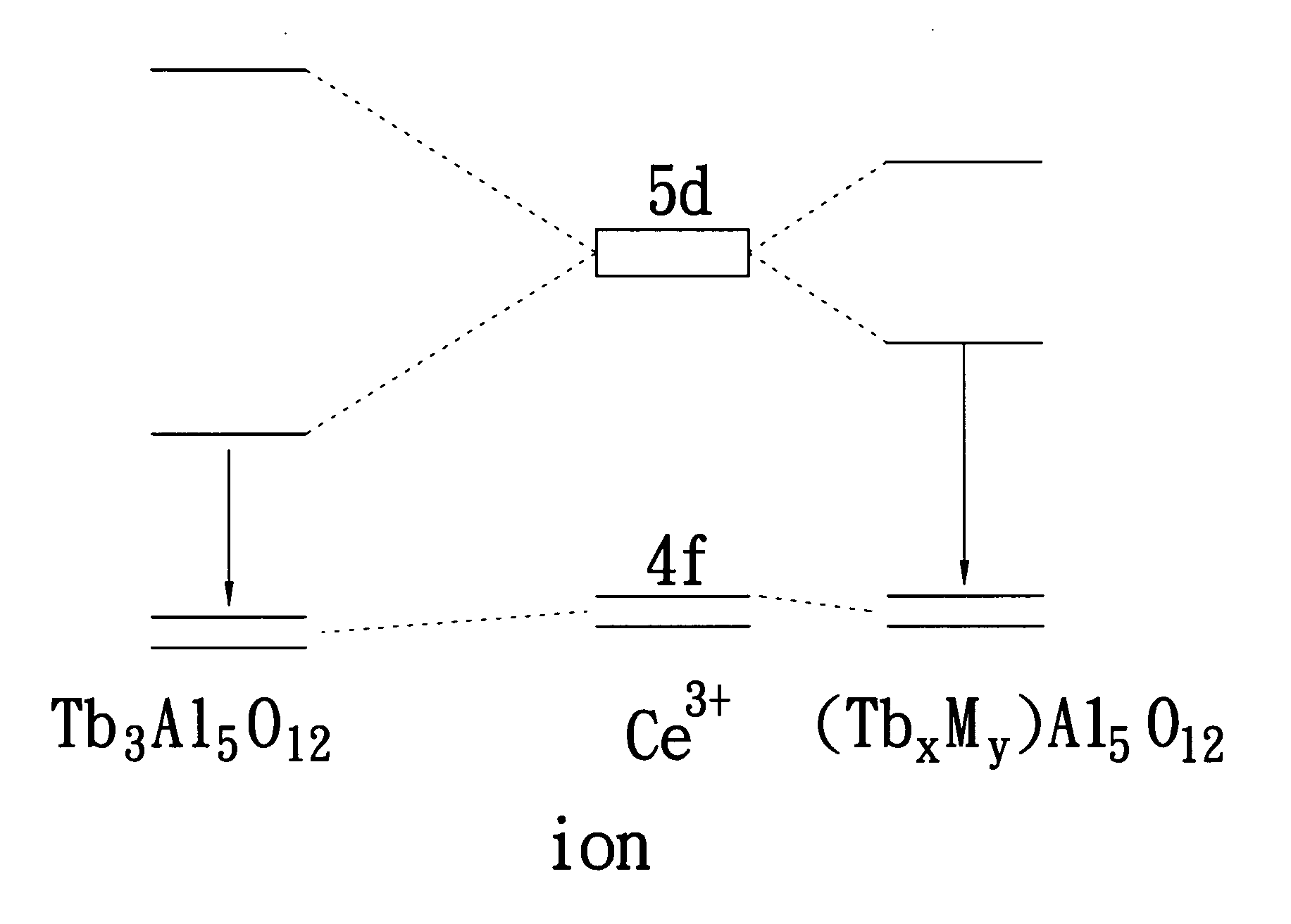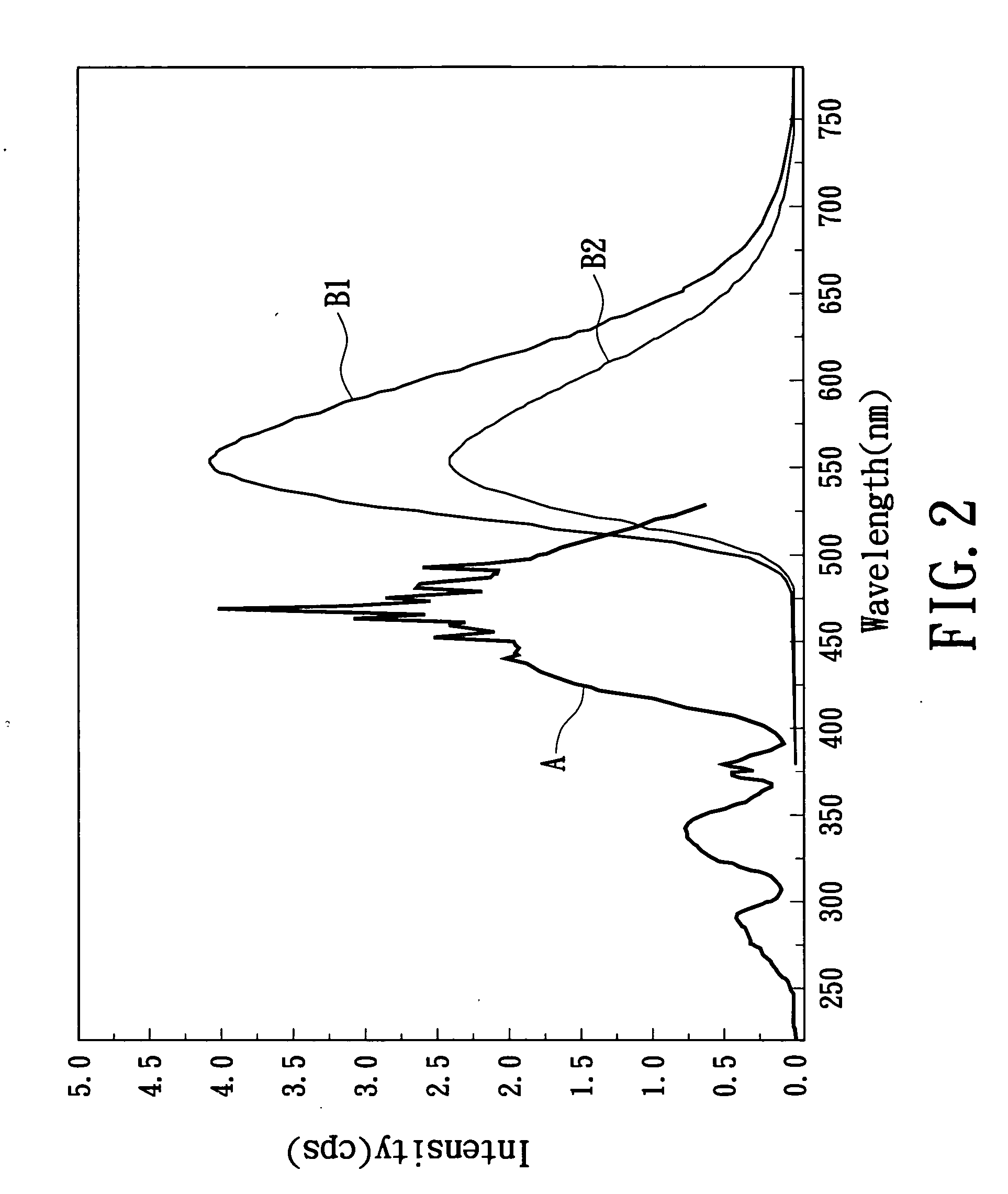Yellow phosphor material and white light-emitting device using the same
a technology of white light and yellow phosphor material, which is applied in the direction of semiconductor devices for light sources, sustainable buildings, lighting and heating apparatus, etc., can solve the problems of inability to obtain accurate white light, inability to use plural leds, and inability to obtain blue leds with fixed wavelengths, etc., to achieve convenient use of blue leds, improve color hue, and improve efficiency
- Summary
- Abstract
- Description
- Claims
- Application Information
AI Technical Summary
Benefits of technology
Problems solved by technology
Method used
Image
Examples
example 1
A. EXAMPLE 1
Solid-State Reaction Process
[0024] 1. Preparing mixture for forming a composition having a stoichiometry of (TbxYyCe0.05)Al5O12 (x=0.65 y=2.3 , x=1.15 y=1.8 , x=2.95 y=0) by mixing and grinding Y(NO3)3.6H2O, Al(NO3)3.9H2O, Ce(NO3)3.6H2O, and Tb4O7 matched the stoichiometry.
[0025] 2. Placing thus-produced mixture in a crucible and heating the mixture for calcination in air at 1000° C. with a heating rate of 5° C. / min for 24 hours and followed by cooling down at a cooling rate of 5° C. / min to form intermediate powders.
[0026] 3. Grinding the calcined powder and then placing the calcined powder again in the crucible for sintering in air for 24 hours with temperature ramp and drop of 5° C. / min.
[0027] 4. Placing the sintered powder in a H2 / N2 (5% / 95%) reductive ambient at 1500° C. for 12 hours for reduction. This reduces Ce4+ to Ce3+. It is noted that this step, which can improve light brightness, is optional.
example 2
B. EXAMPLE 2
Citrate Sol-Gel Process
[0028] 1. Preparing a water solution of a composition having a stoichiometry of (TbxYyCe0.05)Al5O12 (x=0.65 y=2.3, x=1.15 y=1.8, x=2.95 y=0) by adding Y(NO3)3.6H2O, Al(NO3)3.9H2O, Ce(NO3)3.6H2O, and Tb4O7 matched the stoichiometry to form a metallic salt and then placing the metallic salt to DI water.
[0029] 2. Adding citrate of the same mole number as the metal ion as chelate agent to the water solution.
[0030] 3. Adding alkali such as ammonia or ethylene diamine to the water solution in step 2 until the pH value thereof exceeding 10.
[0031] 4. Heating the water solution in step 3 by 100˜120° C. until a sticky solution is formed.
[0032] 5. Cooling the sticky solution and the thermal decomposing it in air with 300° C. to remove most organic material and nitride and oxide to obtain a bitumen ash.
[0033] 6. Placing the ash in step 5 in a crucible and heating the mixture for calcination in air at 1000° C. with a heating rate of 5° C. / min for 24 hour...
example 3
C. EXAMPLE 3
Co-Precipitation Process
[0037] 1. Preparing a water solution of a composition having a stoichiometry of (TbxYyCe0.05)Al5O12 (x=0.65 y=2.3, x=1.15 y=1.8, x=2.95 y=0) by adding Y(NO3)3.6H2O, Al(NO3)3.9H2O, Ce(NO3)3.6H2O, and Tb4O7 matched the stoichiometry to form a metallic salt and then placing the metallic salt to DI water.
[0038] 2. Adding alkali such as ammonia or ethylene diamine to the water solution in step 1 until the pH value thereof exceeding 10.
[0039] 3. Stirring the solution in step 2 and obtaining a white sticky solution by pumping and filtering process.
[0040] 4. Thermal decomposing the white sticky solution in step 3 in air with 300° C. to remove most organic material and nitride and oxide to obtain a bitumen ash.
[0041] 5. Placing the ash in step 5 in a crucible and heating the mixture for calcination in air at 1000° C. with a heating rate of 5° C. / min for 24 hours and followed by cooling down at a cooling rate of 5° C. / min to form intermediate powders....
PUM
| Property | Measurement | Unit |
|---|---|---|
| domination wavelength | aaaaa | aaaaa |
| domination wavelength | aaaaa | aaaaa |
| domination wavelength | aaaaa | aaaaa |
Abstract
Description
Claims
Application Information
 Login to View More
Login to View More - R&D
- Intellectual Property
- Life Sciences
- Materials
- Tech Scout
- Unparalleled Data Quality
- Higher Quality Content
- 60% Fewer Hallucinations
Browse by: Latest US Patents, China's latest patents, Technical Efficacy Thesaurus, Application Domain, Technology Topic, Popular Technical Reports.
© 2025 PatSnap. All rights reserved.Legal|Privacy policy|Modern Slavery Act Transparency Statement|Sitemap|About US| Contact US: help@patsnap.com



